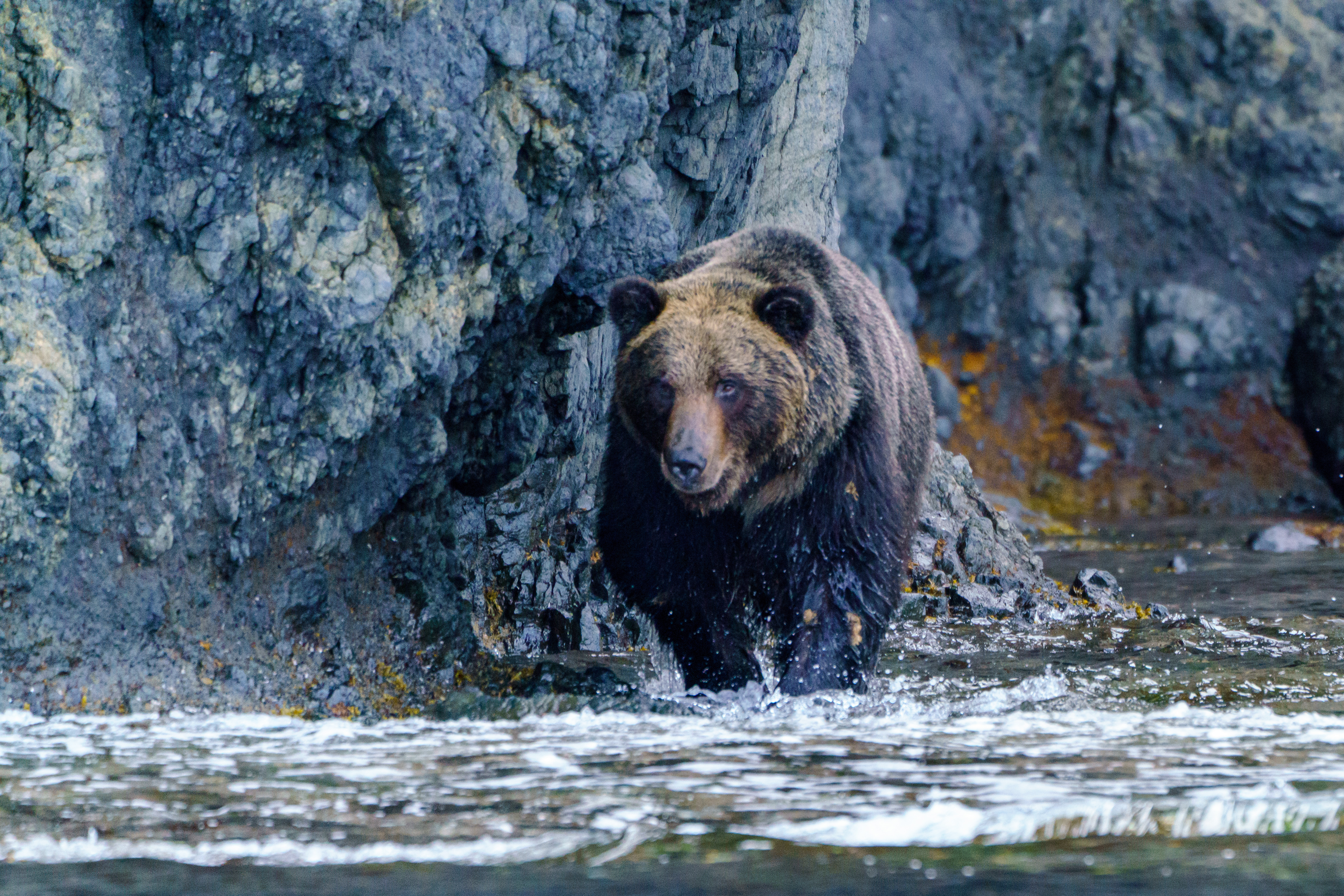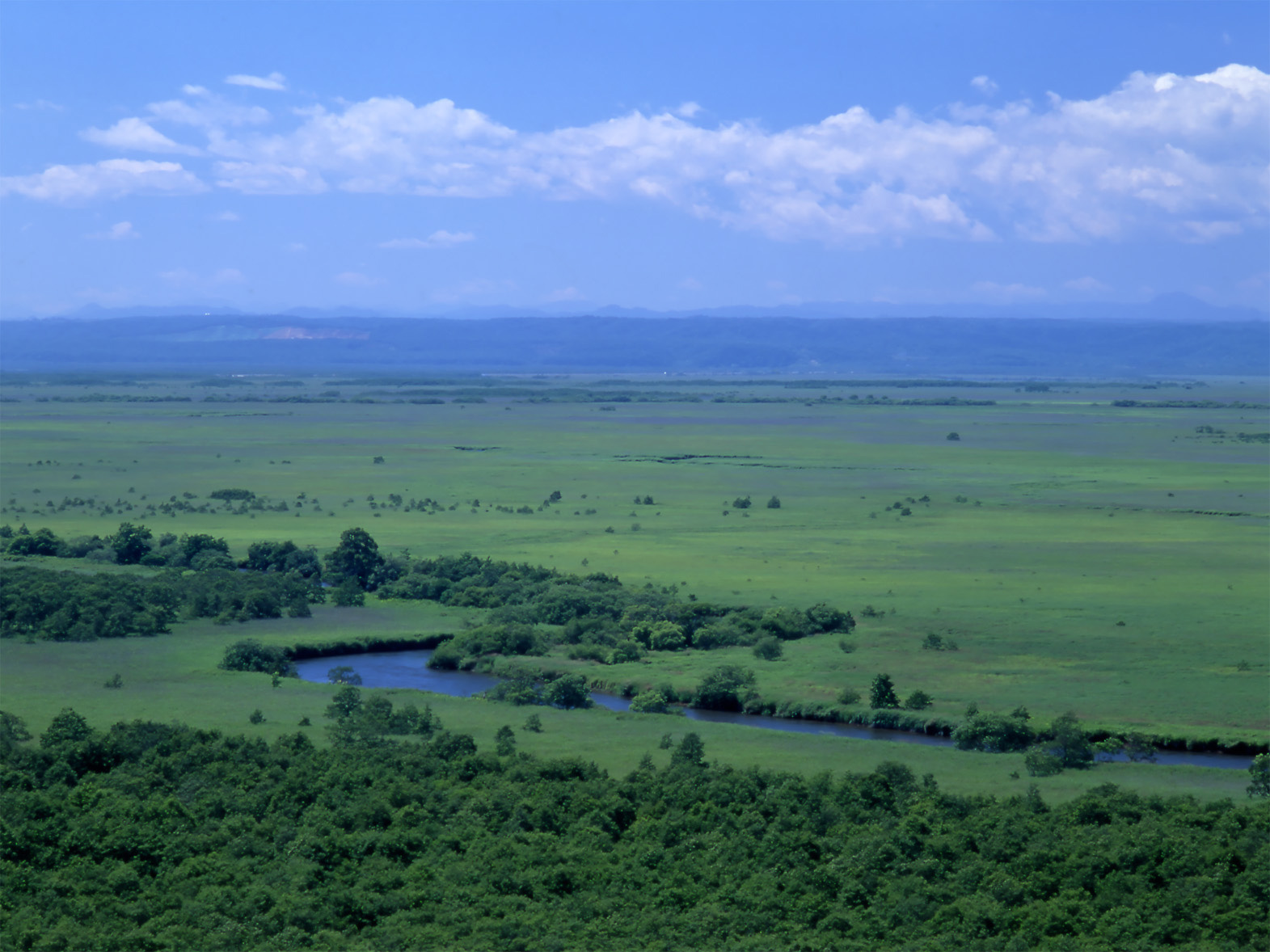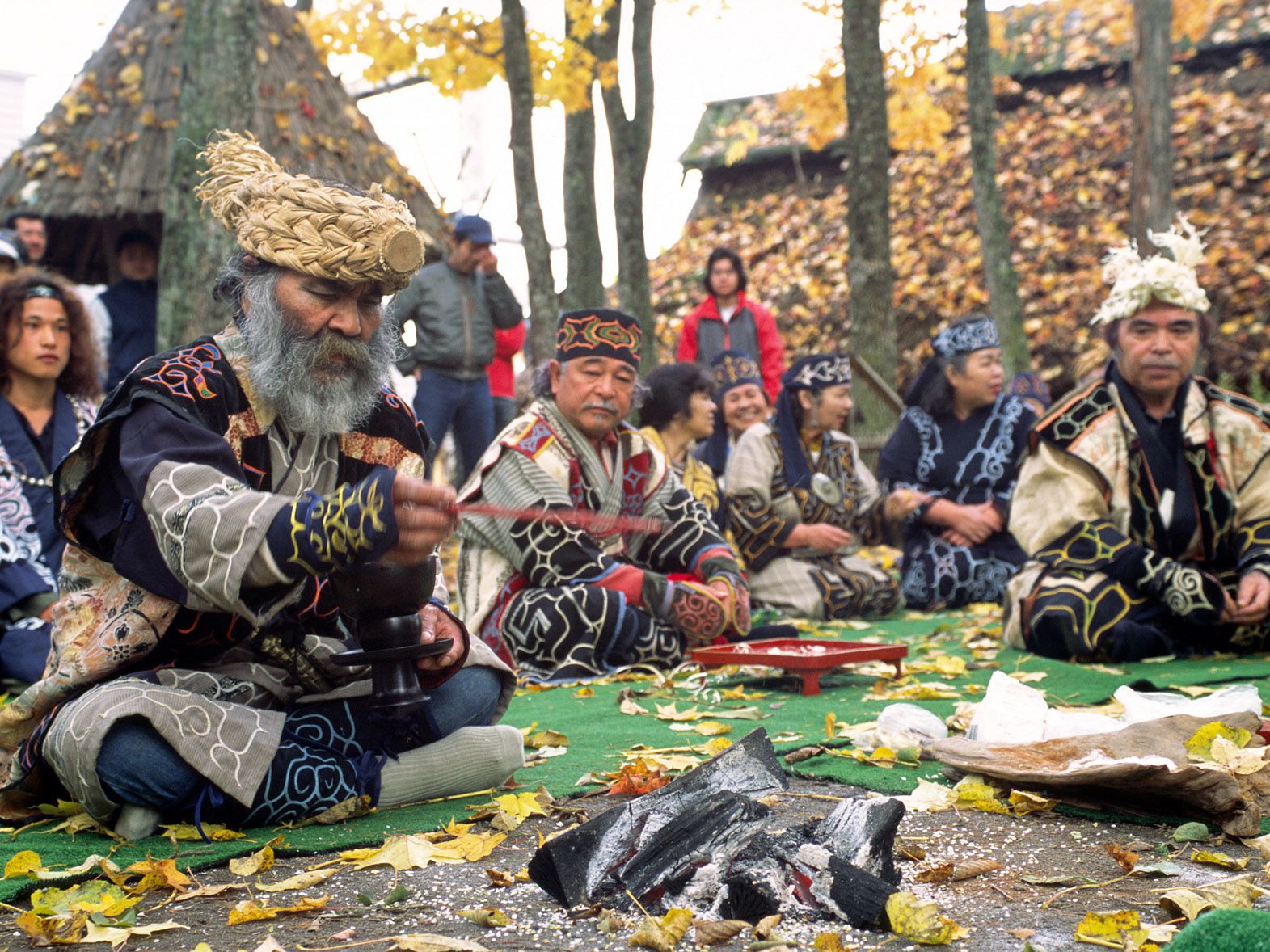14 days
Discover Japan's Northern Wilderness
Your voyage begins where you’ll embark on your international flight to Tokyo Haneda Airport. An overnight trip with a good night’s sleep we hope before your journey into the wilderness.
Once you’ve arrived in Tokyo, there’s time to stretch your legs, grab some lunch and relax before your short flight to Kushiro on the northern island of Hokkaido – the gateway to Japan’s untamed frontier.
The city of Kushiro is set in Japan’s largest natural wetland – home to the only wild population of red-crowned cranes, one of the rarest birds in the world. Kushiro is also a historic fishing port, and here you’ll sample some of the very freshest seafood Japan has to offer. Fishermen from Kushiro are credited with inventing robatayaki, a cooking technique in which fish are flash-barbecued over a charcoal hearth to preserve their delicate flavour. There are now thousands of robata restaurants across Japan – but everyone agrees the most authentic are right here.
Once you’ve safely landed at Kushiro Airport, you’ll meet your English-speaking guide, who’ll be your key to the secrets of this wild northern island as you explore by private car for the next five days. First however, you’ll be whisked to Kushiro Robata – the beautiful, atmospheric wood-lined restaurant where robatayaki was first served.
After dinner, it’s time to get some rest at the ANA Crowne Plaza Hotel near Fisherman’s Wharf – you’ll need it for the adventures to come!
Today you get your first taste of the wild. Your guide will meet you after breakfast to check out the delicacies at Kushiro’s bustling Washo Ichiba market. Then it’s a short ride on the Norokko Train, a classic steam locomotive, into the depths of the marshes.
The best way to see the wetlands’ reclusive wildlife is from the water, so you’ll set out on a peaceful canoe trip on the upper reaches of the Kushiro River. After lunch at Restaurant Ordinaire in Kushiro, there’s an opportunity to see the red-crowned cranes at the Tancho Tsuru Nature Park. Japanese culture has been entranced by these beautiful birds for thousands of years – if you’ve ever seen an origami crane, this is your chance to catch a glimpse of the real thing at a park established to protect their habitats.
Next, it’s up into the mountains to Akankohan for a spectacular view of Lake Akan, a beautiful volcanic lake famous for its healing waters and for the “marimo” – a rare species of moss that naturally forms into soft velvety spheres. You’ll be spending the night at the Akan Yuku no Sato Tsuruga, a traditional onsen spa hotel where you can soak in hot spring waters right on the edge of the lake.
After a hearty buffet dinner, you’ll get a chance to meet some of the locals. The Ainu are the indigenous people of this island, and despite being conquered by Japan over 1,000 years ago they’ve still preserved their distinct culture. Lake Akan is home to the Akanko Ainu Kotan, the largest Ainu village in Japan. A short walk from your hotel, here you’ll sample ancient Ainu handicrafts, and experience a once-in-a-lifetime performance of traditional Ainu dance at the Ikoro Ainu Theatre. The Ainu use their dances to communicate with the kamuy, the gods and spirits of the earth – let them transport you to another world.
Today is all about the views: you’ll be treated to some of the most breathtaking landscapes in the wildest corner of Japan. Your day begins after a hotel breakfast with a walk through the primeval Hikari no Mori, or Forest of Light, a mysterious wood dotted with unique geothermal vents.
Next, your private car will whisk you off to enjoy some stunning panoramas. Bihoro Pass is a gap in the mountains that offers views over Lake Kussharo, the largest crater lake in Japan. This ancient landscape is still full of mysteries – Kussharo is known as the “Japanese Loch Ness” after sightings of a giant sea-monster in its depths. Bring your binoculars and find out if the rumours are true!
Lunch is at the Tsuruga Auberge Sora on the shores of the lake, where classic French cooking is combined with local Japanese ingredients. Then, you’ll wander over the slopes of Mount Iou, a prehistoric landscape wreathed in clouds of volcanic smoke.
Nearby lies Lake Mashu. Set in the heart of an ancient caldera, it’s surrounded by sheer crater walls plunging into brilliant cobalt-blue waters. No wonder it’s widely considered to be the most beautiful lake in the country! You’ll see it from the Lake Mashu Daiichi Observatory – keep an eye out for the ghostly rolling fog that makes the area so famous.
Then it’s time to say goodbye to Akan National Park – your next stop is the remote Shiretoko Peninsula, the easternmost tip of mainland Japan, at the very edge of the world.
You’ll arrive at Kitakobushi Shiretoko Hotel & Resort just before 7pm, where you can enjoy a buffet of local produce and relax in a hot spring bath overlooking the Okhotsk Sea. Get some much-needed rest – because in the morning, you’ll be setting out to meet the whales.
Recognised as a UNESCO World Heritage Site, the rich waters around Shiretoko are full of fish – and where there are fish, there are whales. After breakfast at the hotel, you’ll start the day with a cruise around the peninsula, where you’ll get a chance to see playful orca and porpoises up close, and you may even spot huge minke and sperm whales breaching the surface.
Its not just the whales who get to enjoy the sea’s bounty: once you’re back on dry land, you’ll try local sashimi and roasted venison at the Shiretoko Serai, a guesthouse inspired by the rest stops on the old Silk Road.
In the afternoon, you’ll get to explore the peninsula’s Five Lakes region. These small, tranquil lakes were formed thousands of years ago in a volcanic eruption; today, they’re a haven for wildlife, including fluffy red foxes and the magnificent Ezo deer. Then it’s a short drive from there to the magical Oshinkoshin Waterfall, which cascades down the verdant hills and into the Sea of Okhotsk.
After a jam-packed day of sights and wonders, you’ll make a final stop before dinner at Yuhidai Observatory for a contemplative view of the setting sun. Tonight’s restaurant Sandaime Chiba Shoten, where Chef Yutaka Chiba serves his inspired Japanese take on Western cuisine. You’ll then return to your hotel for a touch of R&R, but you may venture out again for an optional night-time animal-watching excursion.
By now you’ll have seen cranes, deer, and whales, but we’ve saved Hokkaido’s most spectacular inhabitants for last: the brown bears, which the Ainu people revere as gods. Every year, once the snows have melted, the bears come out from hibernation to wander over the Shiretoko Peninsula – and because they give birth over the winter, they’re sometimes accompanied by adorable cubs.
The peninsula has over 500 wild bears, so in the summer months the tip of Shiretoko is closed to visitors to give them some space. The best way to safely observe these magnificent creatures is from the sea. After breakfast at the hotel, you’ll take another boat out (depending on guest numbers) to circle the peninsula’s rocky beaches and river mouths, which are the bears’ favourite hunting grounds. You might even spot some cubs playing in the surf!
Once your bear-spotting cruise has returned to dock, it’s time for your last meal in Hokkaido. Restaurant Shiretoko Satomi is famous for its home-style seafood bowls, so dig in!
After lunch, it’s off to the airport to say goodbye to your guide and catch your flight to Kyoto. This is the end of your time in Hokkaido – but there’s plenty of Japan still to see!
You’ll arrive at Itami Airport in central Japan that evening, and will be driven into the heart of Kyoto. Once you’re checked in at the three-star Hotel new Hankyu Kyoto (or another of similar quality), you’re free to explore the city’s streets and try out the local cuisine. The friendly hotel staff will be able to recommend some local spots, but we suggest checking out a local noodle bar – they say the soft Kyoto water makes for soba noodles you won’t find anywhere else.
Your new English-speaking guide will meet you at the hotel after breakfast, and your first day in the heart of historic Japan starts with a voyage into the valley of the Hozu River. You’ll travel to Kameoka by train, where you’ll take to the waters on a boat. The cheerful boatmen still guide these sturdy craft with bamboo poles, and the journey back down to Kyoto is a vision of the Japanese landscape straight out of a painting – from the Sakura cherry blossoms of spring to the deep orange leaves of autumn.
You’ll disembark at Arashiyama, a district right on the western edge of Kyoto that’s known for its sprawling temple complexes. After a meal of shabu-shabu hotpot, you’ll get a chance to visit the ancient Tenryu-ji Temple, one of the most important centres of Zen Buddhism. This holy site is famed for its tranquil gardens, which have been cleverly laid out to incorporate the surrounding landscape into their harmonious design.
From the temple, you’ll stroll through the iconic and unearthly bamboo forest. This tunnel through deep groves of bamboo isn’t just visually stunning – the sound of the trees rustling in the silent air has been added to the Ministry of the Environment’s list of “100 Soundscapes of Japan.” Your walk will lead you to the Okochi-Sanso Villa, which was once the home of silent film star Okochi Denjiro. He was beloved for his roles in period dramas, and the house and gardens are a feast of different architectural styles from across Japanese history. Once you take the train back into the centre of Kyoto, the rest of the evening is up to you. This city is full of hidden gems – consider a romantic sunset stroll long the leafy Philosopher’s Path, or mingle with real-life geisha on the winding cobblestone streets of the Gion district.
After your usual hotel breakfast, this will be a jam-packed day in which you’ll get to experience some of Kyoto’s greatest treasures by private car – but first, it’s important to wear the right attire. Your guide will meet you after breakfast to take you to a nearby rental store, where you can try on traditional silk kimono. If you like, you can keep it on while you continue the tour.
Today, you’ll be visiting three temples representing the rich spiritual heritage of the city. First up is Kiyomizu-dera, the Pure Water Temple, named for the waterfall that gurgles under its main hall. As it passes through the temple, the water branches into three streams: drinking from one is believed to bring longevity, the second will improve your career, and the third will help you find love. Pick just one though – they say it only works if you’re humble enough not to drink from all three.
Next you’ll see the mysterious Shinto shrine of Kifune, reached through a stone stairway lined with red wooden lanterns. Here you can consult the fortune-telling waters – dip a paper token in the sacred pool and Japanese characters will appear to tell you your fate. Don’t worry if you can’t read Japanese, though; these days, the tokens also come with a QR code so you can translate your destiny on your phone.
Just below the shrine, you’ll have a leisurely lunch of Kyoto delicacies at Kifunebeniya, a restaurant in the “kawadoko” style – where you sit on a platform built directly over a fast-moving river to keep you cool in the midday heat.
Finally, you’ll visit Kinkaju-ji – the glorious Golden Pavilion. This Zen temple is aptly named: its two upper stories are entirely coated in gold. Then, once you’ve returned your kimono to the store, there’s one last chance to wander the ancient capital for yourself before the adventure continues.
Today, you’ll follow the trail of Japan’s proud warrior caste: the samurai. Your training begins after breakfast, as you say goodbye to the dreaming shrines of Kyoto and hit the road for the imposing Himeji Castle. You’ll be driving with an English-speaking guide who’ll escort you for the next few days.
This great feudal pile is one of only a handful of Japanese castles to have stood through hundreds of years of wars, fires and earthquakes unscathed. But it’s not all brawn – in Japan it’s also known as the White Heron Castle for its elegance and the multiple featherlike roofs. You’ll see the clever fortifications built into the design, which is full of hidden nooks and secret passages – plus the maze of picturesque alleys leading up to the keep, where entire armies could get lost on their way to the siege.
After seeing the castle, you’ll take a true warrior’s lunch at Kassui-ken, a restaurant sitting just outside the castle’s moat where you can try strips of Japanese beef grilled on a ceramic plate.
Of course, a samurai is nothing without his sword, so for your next stop you’ll head inland to the tiny town of Osafune. For hundreds of years, this village has been home to Japan’s greatest steelsmiths, and it’s still famous for its handcrafted katana today.
Here you’ll find the Bizen Osafune Sword Village, a museum and working forge where you can see some of these masterpieces of craftsmanship from across the centuries, and even try on samurai armour for yourself. Around the courtyard, you can learn how katana are made with a demonstration from some master swordsmiths, who still use the time-honoured techniques that made this town famous. Afterwards, you can even buy a katana for yourself – or if you’re looking for a souvenir that won’t break the bank, the same techniques are used to craft some beautiful sushi knives.
You’ll be spending the night in the Iya Valley, a land of misty gorges and
thatched-roof villages almost untouched by the modern world.
Accommodation is at Hotel Kazurabashi – it’s the only hotel in this
secluded valley. It also features a traditional open-air hot bath on a
nearby mountaintop, which can only be reached by cable car – soak in its
steaming rock pools with the entire valley spread out before you.
The hotel is named after the Kazura Bridge, which is a short walk away.
This narrow rope bridge hanging over the ravine is made from twisted
mountain vines, and it’s one of the last natural bridges remaining in Japan.
Cross it if you dare – you’ll see the water rushing 50 feet beneath you
through the slats, so it’s not for the faint of heart!
Dinner is a true taste of traditional village life. You’ll sit Japanese-style –
on the floor – around low tables, each with its own traditional charcoal
hearth, where local ingredients will be prepared in front of you.
After a hearty Japanese breakfast, it’s time to hit the road, again by private car: today, you’ll be spending time with some of Japan’s friendliest residents. But first, a pit stop at the Kirosan Observatory, where you can take in panoramic views of the straits between Honshu and Shikoku. This busy waterway is crowded with bejewelled islands, many of them connected by the awesome Kurushima Kaikyo Bridge, the world’s first-ever triple suspension bridge.
You’re headed for the island of Hakata. Once a centre of sea-salt
production, it’s now better known for its sandy beaches and the
local salted vanilla ice cream – and for its friendly dolphins. At the
Shimanami Dolphin Park, these fun-loving creatures will swim
right up to you, and you can feed them out of your hand. If you’d
like to get to know the dolphins better, you can touch them or –for an unforgettable experience – even join them in the water.
Lunch is up to you, but your guide will be able to point you
towards some great local spots. Next, you’ll stop off again at the
summit of Mount Takami, which offers glittering views from the
other side of the strait. Then it’s on to Hiroshima. Once you’ve
checked in at the four-star Hotel Granvia Hiroshima (or a similar
hotel), the rest of the evening is up to you. But you can’t visit
Hiroshima without trying its tastiest export, okonomiyaki. This
savoury pancake is grilled on the street and piled high with extra
toppings. Try it with noodles, tender pork, succulent prawns, or –
the Hiroshima speciality – local fried oysters.
The Second World War ended when two atomic bombs were dropped on Hiroshima and Nagasaki – the only time these terrifying weapons have ever been used in war. Ever since it was rebuilt, the city of Hiroshima has been dedicated to the pursuit of world peace.
After breakfast, you’ll make your way by train from Hiroshima Station to Miyajimaguchi, where you’ll catch the ferry to the tranquil Miyajima – which translates as “Shrine Island”. The ancient Itsukushima Shrine here is dedicated to the Shinto goddesses of the sea and the storms, which is why it’s built on floating platforms over the water. Here you’ll see the iconic floating gate in the middle of the bay: in feudal times, pilgrims had to paddle their boats through the gate to enter the shrine. Lunch will be up to you, but we recommend the local oysters, which can be prepared in all sorts of ways.
You’ll return to the city that afternoon, heading to the Peace Memorial Park. You can take some time to contemplate in the gardens that mark ground zero, or learn more about the bombings at the Hiroshima Peace Museum. The Atomic Bomb Dome stands near the epicentre – an old exhibition hall that sat directly under the blast and was one of the few buildings in the city left mostly intact. The ruins still stand as a memorial.
That evening, you’re once again free to explore the rest of the city yourself. Another local speciality well worth trying is smoky grilled anago, or freshwater eel. It’s served simply over rice, and it’s impossibly moreish.
Today, you’ll catch the Bullet Train after breakfast to the final stop on your Japanese adventure: Tokyo. Your guide will leave you here, and your bags will be sent on ahead of you, so all you need to do is sit back, enjoy the packed lunch we’ll prepare for you, and watch the Japanese countryside flash past at 300km/h while you plan out your day in the biggest city in the world.
You’ll arrive in Tokyo at 12.54 pm exactly – Bullet Trains are so punctual, they lose less than one minute per year. You’ll meet your new English-speaking guide on the station platform for an afternoon of sightseeing by private car.
No visit to Tokyo would be complete without seeing the Imperial Palace, where the world’s oldest unbroken dynasty – and its most reclusive – reigns from the Chrysanthemum Throne. You’ll tour its stately moats and walled gardens, before heading out to the historic Asakusa neighbourhood to marvel at the nearly 1,400 year old Senso-ji Temple. You can approach the temple along the Nakamise, a promenade lined with authentic stalls selling the best of Japanese crafts, from delicate ceramics to kimono and sensu folding fans. Finally you’ll gaze out at the whole city from the deck of the 300m Tokyo Tower. As night sets in, you’ll see the lights come on across this truly vast city, stretching to the horizon before your eyes.
Dinner is up to you, but there are
incredible options to suit everyone. On
the upper end of the scale, Tokyo has
more Michelin stars than any other city in
the world – your guide will be sure to
know a few places for truly top-notch
sushi. Or for something more convivial,
head down to Kabukicho’s Golden Gai
district: a maze of tight alleys hosting
hundreds of tiny pubs, each with its own
unique character. Some of these only seat
three or four patrons at a time, and you’ll
be treated to sakana – little tapas-style
plates of noodles, meat or vegetables –
along with your local beer or sake.
You will stay at the four-star Akasaka
Excel Hotel Tokyu (or another hotel of
equivalent quality) right in the city centre.
On the last full day of your trip, Tokyo is yours to explore after breakfast at your hotel. This city is far too huge to see everything at once, so pick out a few destinations and enjoy them to the fullest.
Perhaps the most iconic district is Akihabara, the spiritual home of the otaku subculture. What started as the local centre for household electronics – think stereos and washing machines – is now the global centre of all things anime. Its neon-drenched streets are plastered with brightly coloured characters from cartoons and comic books: the perfect place to delve into Japanese nerd culture in all its oddball glory.
For something more sedate, head to Roppongi to experience the best in contemporary Japanese art, or to Odaiba to see cutting-edge robotics at the Museum of Emerging Science and Innovation. If you can’t get enough of the city views, look out for the Tokyo Skytree, the second-tallest manmade structure in the world, with unparalleled vistas stretching across the city to the snowy slopes of Mount Fuji.
But perhaps the best thing to do in Tokyo is to simply get lost: in this thrumming maze of marvels, there’s something fascinating around every corner. Lunch and dinner are both up to you today.
Today’s the last day of your trip, and we’ll be sad to see you go – but the memories you’ve made here will last a lifetime. After breakfast at the hotel, your private car will pick you up for a final trip to Haneda Airport, where you’ll fly back to home.
Dates & Prices
- Board: 12 nights at three or four-star hotels
- Meals: 12 hotel breakfasts, eight lunches (including one sandwich box), five dinners
- Bullet Train tickets: One journey in reserved second-class seats (Hiroshima to Tokyo)
- English-speaking guide: Per itinerary (including tip and allowance)
- Entrance and activity fees: Per itinerary
- Local transport: Bus, private car, train, cruise boat, canoe and ferry all per itinerary
- Domestic flight from New Chitose Airport to Itami Airport
- International flights and domestic flight from Haneda to Kushiro
- Certain meals, per itinerary
- Optional animal watching tour at night on day five
- Personal expenses
- Other items not mentioned in the itinerary
- Travel Insurance.
Accommodation
3 to 4 star hotels as mentioned in the itinerary, subject to availability.
Signature Experiences for This Tour
Outside Japan’s buzzing cities, there’s a world of unspoilt scenery and wild nature that’s unlike anything else on Earth. On this tour, you’ll spend five days in the dramatic wilderness of eastern Hokkaido, before heading south to immerse yourself in Japanese culture, both ancient and cutting-edge.



DURATION: 14 days / 12 nights
ARRIVAL: Fly into Tokyo Haneda Airport, connecting to Kushiro Airport
DEPARTURE: Depart from Haneda Airport
WHEN TO VISIT: This tour is at its best between June and August
Nature You’ll walk smoke-belching mountains, visit jaw-dropping lakes, and meet some of Japan’s glorious wildlife – from fuzzy bear cubs to the huge whales of the deep.
Luxury Soak in hot springs on a secluded mountaintop, pamper yourself in a silk kimono, and enjoy delicate cuisine in the refined ancient capital – you’ll experience Japan in true imperial style.
Tradition Discover the secrets of the indigenous Ainu people of the north, and explore the legendary temples, castles and gardens of feudal Japan.
Adventure Whether it’s swimming with dolphins, canoeing through the wilderness or looking out for the legendary monster of Lake Kussharo, excitement is never far away!
Check availability instantly and secure your reservation NOW via CHECK and BOOK
We Magical Explorer Ltd reserve our copyright, please contact us to obtain permission for use of any photos or literature from this site.
We thank our friends at the Japan National Tourist Organisation and partners for use of various images on this site.
How to book
Hidden Wonderland of Japan
Grand Japan Tour
Wonders of Japan
Japan Explorer
Classic Japan
Cultural Japan
Magical Japan
Japan Cherry Blossom Tour
Discover Japan's Northern Wilderness
The Roof of Japan
A Japanese Adventure
History and Heritage of Kyushu
Luxury and Gastronomy in Hokkaido and Beyond
Nature’s Fireworks in Hokkaido
Japan Autumn Leaves tour



Sign up to our newsletter for special offers and updates

Our Company is based in Cheshire, UK. Our tours are available to all English speaking customers living across the world and we have many customers from USA, Canada and Australia.
We now bring exclusive online cultural and wellbeing experiences to you!
Magical ExplorerSaturday: 10:00am - 4:00pm
Please complete the contact form below and one of our tour specialists will contact you within 24 hours.